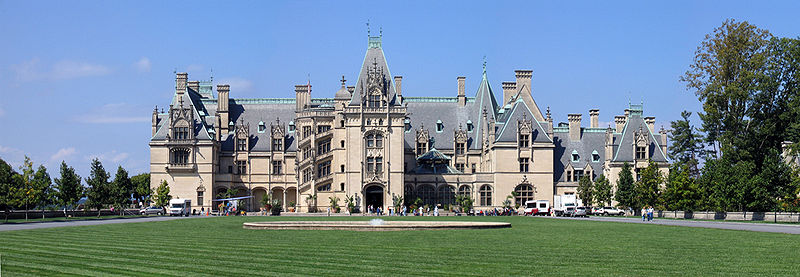A Home Built On Love

Though they passed away years ago, George and Edith Vanderbilt might still be enjoying the lavish lifestyle of the Biltmore House outside Asheville. Some visitors there claim to have seen George’s shadowy figure in the library when there is a storm coming. Others passing through say they heard Edith’s voice whispering “George,” beckoning him from the library to join the party, with sounds of clinking glasses, laughter, music and splashes coming from the now-empty swimming pool.
Perhaps you can’t take it with you, but maybe you can still enjoy it if you hang around. Whether their ghosts are there or not, it is very true that George and Edith had reason to stay. George was born into the fantastically wealthy Vanderbilt family of New York in 1862. The family business, much of which came from steamboats and railroads, was run by George’s older brothers after his father’s death. That fact, not to mention a large inheritance, left George to pursue his own intellectual and artistic interests.
George traveled extensively and was fluent in several languages. After visiting western North Carolina, he decided to build his own country estate in 1888. At the tender age of 26, George purchased 125,000 acres and had a 135,000 square foot home built on the model of the Chateau de Blois in the Loire Valley of France. The house is still the largest private home in this country.
When traveling in France as perhaps America’s most eligible bachelor, George met Edith Stuyvesant Dresser. She had moved to Paris from Newport, Rhode Island along with four siblings when her guardian grandparents died. After a short engagement, George and Edith married in 1898 at the American Cathedral in Paris.
After moving his bride to his little fortress in North Carolina, the young couple settled in and pursued separate but complementary interests. George was quiet and thoughtful, and built a 20,000 volume library that he spent much time enjoying. Edith was independent and industrious. They were socially progressive people who created programs and initiatives that contributed to the lives of the people of the Blue Ridge Mountains.
George was very interested in horticulture and agriculture, overseeing experiments in scientific farming, animal breeding and forestry. He hired Gifford Pinchot – who would go on to be the first chief of the United States Forest Service – to manage the estate’s forests. Biltmore was the first professionally managed forest in the country and would be the home of the Biltmore School of Forestry.
By all accounts, the couple had a loving and supportive relationship. They welcomed daughter Cornelia in 1900 to the family. Known for his generosity toward his employees at Biltmore, George held a Christmas celebration each year for their children, with presents for every child. He also paid for the expenses of the nearby All Souls Church so their collections could go directly to charities in the area.
The Vanderbilts made what came to be a fortuitous choice when in 1912 they booked passage on the Titanic but then changed their minds after being warned about the perils of a maiden voyage. Because they changed their plans last minute, their luggage and servant were on board when the ship went down with 1,517 souls aboard.
It was a shock to Edith and 13-year-old Cornelia when George died in 1914 of complications from an appendectomy. He was only 51 years old. Devastated but resolute, Edith carried on as a devoted mother and conscientious employer for the families who depended on Biltmore for their livelihood. To continue George’s legacy and preserve the estate’s viability for future generations, Edith sold part of their woodlands – the 86,000 acre Pisgah Forest – for $5 per acre to the United States Forest Service. Pisgah was to be the country’s first national forest.
After Edith’s death in 1958, the Biltmore Estate properties eventually passed through Cornelia to her sons George and William Cecil. George chose to take the lands and Biltmore Farms. William chose the house and is largely credited with preserving the chateau for all to enjoy. Today, surviving family members are still involved in running the Biltmore Company, employing over 2,400 people who maintain the 8,000 acres of the house, hotel, winery, restaurants and shops.
No doubt George and Edith Vanderbilt were born of privilege and social standing; they had a head start on whatever life’s challenges would bring them. But their devotion to each other, to their family, to their employees and to their community were exemplary. Stepping into Biltmore House, you can feel their presence still.











Leave a Reply